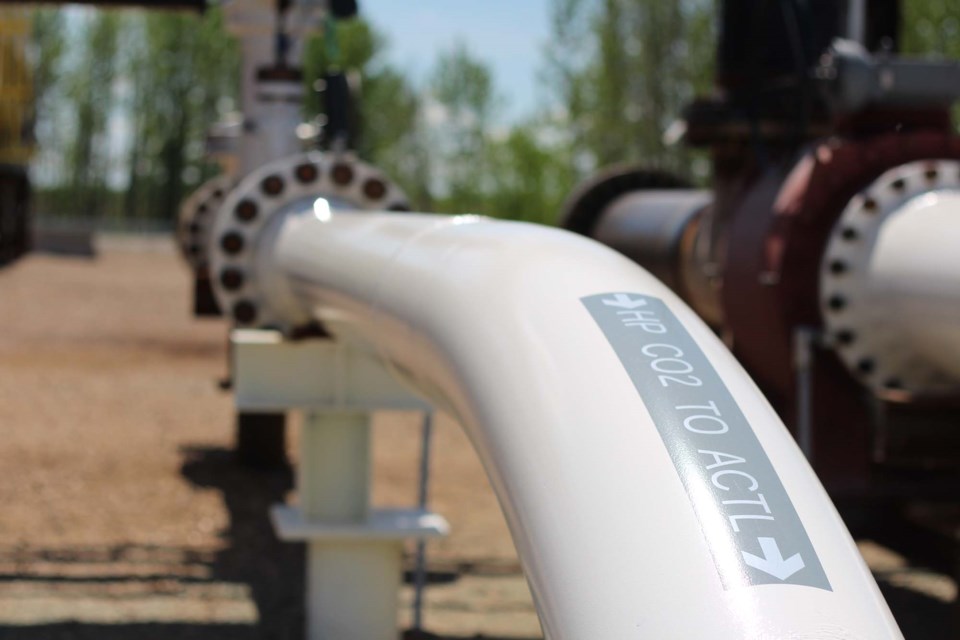Editor's Note: The last of three community consultations that were scheduled over the past week is set to take place today in Glendon from 3-7 p.m. at the Glendon Seniors Centre. The consultation is being put on by Pathways Alliance. A similar event took place in St. Paul on Nov. 1 and a previous event took place in Cold Lake on Oct. 25.
COLD LAKE - A proposed carbon capture and storage (CCS) project to be built in the Cold Lake region is facing opposition from a local Indigenous community.
The initiative, which is being spearheaded by Pathways Alliance, involves a proposed CO2 pipeline constructed from high strength carbon steel appropriate for C02 transport. The line will follow existing pipeline right-of-way corridors. Once fully complete, the line would transport captured CO2 from more than 20 oil sands facilities to a hub in the Cold Lake region for safe, permanent underground storage.
According to Pathways Alliance, this will reduce net C02 emissions from operations by 10-12 million tons per year in the first phase of the project alone. The storage hub isn’t a facility, but a deep natural formation located deep below the Earth’s surface, well below any freshwater sources. In this case, it is a deep saline aquifer, a geological formation comprised of water-permeable rocks in the Cold Lake region.
Being out of sight doesn't make it out of mind, says Chief Kelsey Jacko of Cold Lake First Nations.
The northeastern Alberta band leader says there have been many concerns about the long-term implications such a project could have on the community, including potential risks to the health of fish and animals, the release of poisonous gas (C02)-not only from pipelines-but also from underground fissures and pathways in existing well sites on the First Nation community’s reserves and throughout its territory, as well as harm the community’s freshwater supply. He also says an underground storage could also lead to increased seismic activity in the area.
“Our elders and community are being asked to clean up everyone’s garbage,” Jacko said. “For years, industry and government have benefited from the oil sands development and now that they have a problem with waste products, they want our community to take all the risk. The carbon will be stored forever, and no one can predict what the impacts might be to us 100 or 200 or 500 years from now.”
Pathways Alliance President Kendall Dilling says a detailed evaluation of the proposed storage reservoir near Cold Lake is ongoing. Currently, hundreds of experts are conducting pre-engineering plans and other work that will be part of the formal regulatory application filed with the Alberta Energy Regulator.
According to Dilling, Pathways Alliance has initiated consultation work with Indigenous groups and communities near the proposed CCS network.
“These relationships will continue to be important as the project advances to ensure Alberta’s oil sands resources are developed sustainably,” he said.
That’s news to Chief Jacko.
He says there have been no formal consultations, neither with the governments of Alberta or Canada, nor with Pathways Alliance.
“We have been asking for detailed technical information for over 18 months, and Pathways has not answered our questions,” he told Lakeland This Week. “No, we have not had any meaningful discussion on how this project, if it were to proceed, would provide economic benefits to our nation.”
According to Pathways information, the proposed project represents a $16.5 billion investment in northeastern Alberta, creating 105,640 jobs through construction and operations. About one-third of those jobs — 35,000 — are expected to make up the construction phase alone.
“Apart from the great demand for local businesses and Indigenous companies in the supply chain, we are in discussions with Indigenous communities about the potential for a mutually beneficial partnership on our CCS project,” Dilling said, adding that the fight against climate change in the decades to come is going to be a critical challenge, and CCS is an essential solution to that challenge.
Alberta is the perfect location to implement this technology at scale, he says.
“We have the ideal geology for carbon sequestration, world-class regulatory oversight, and a highly experienced industry,” he said, explaining that the province has a strong track record of successfully deploying CCS in the cement, steel, and oil and gas industries.
Using the Quest and Alberta Carbon Trunk Line projects examples — one with storage containment near Lacombe and the other near Fort Saskatchewan — he said that to date, they have safely captured, transported, and stored more than 10 million tons of C02.
The Pathways proposal is one of many plans already approved by the provincial government.
“In 2022, the Government of Alberta selected over 20 proposals to develop carbon storage hubs in the province and our proposed project is one of them,” he stated.
Dilling says that Alberta, and the Cold Lake region in particular, has long benefited from a strong energy sector that generates thousands of jobs and helps fund essential services, including health care, education, and roads.
“To keep these benefits for decades to come, we must continue raising the bar to protect the environment by reducing emissions and help our country achieve a sustainable future.”
Despite the environmental and economic advantages touted by Pathways Alliance, Jacko questions how beneficial the project will truly be.
“Will this project even work…or is it just a huge expenditure of public money to greenwash industry and allow for more and more environmental damage?
Discussions, opposition and support for the project continue.
Officials with Pathways have given a wide window for a development timeline, telling municipal leaders at several public meetings they would like to be operating between 2027 and 2030.


.jpg;w=120;h=80;mode=crop)
